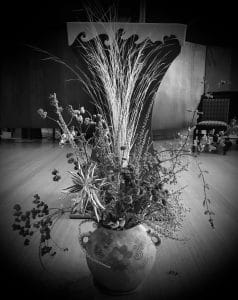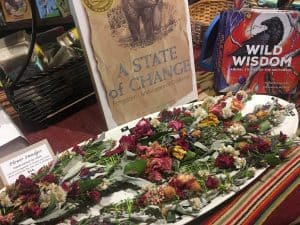
October, the month of new beginnings in the natural garden, and the time to get a few things done before the rains come. We’ll enjoy cooler nights, shorter periods of daylight, garden soils that are still warm enough to promote root growth, and on many species, a “second spring” bloom. Bright flowers and lucious new growth emerging from dusty branch tips, tender buds that have been patiently awaiting this special time to emerge from hiding and show their true colors. We’ll also see the shift change in our bird visitors, as some species migrate in and others out.
Let’s leave summer 2018 behind, far behind, in the dust, (literally) since there is so much of it everywhere. Last summer was so hot and dry, with many destructive wildfires, a few heat waves, and long stressful days that taxed the stamina of both gardeners and plants. Much of our stress can be attributed to the paltry rain totals for the prior season (2017/18), less than 6”. Let’s hope for more precipitation this year, because believe me, if we have another dry winter, next summer will be hard beyond belief. Calling all gardeners, you eternal optimists, unite! The rains will come and heal our wounds! At this writing, Hurricane Rosa is forecast to make landfall in north-central Baja and dump a lot of water in our southern deserts October 1st through 4th. Southern California might see some good rain as well. Yes!
Watering
Unless Rosa gives us an inch or more, this is a perfect time to give your garden a head start on the season by providing one more (hopefully the last one until around May) deep soak. See https://californianativeplants.com/wateringnativeplants for precise details. If you have been following this monthly series, you probably have this memorized: A “deep soak” means you run the sprinkler or hose end sprinkler about 30-40 minutes a day, three days in a row (total 90+ minutes) in consecutive early mornings to thoroughly soak all the ground, applying approx. 1.5” total precipitation. In summer, you only do this about once a month. With normal rain amounts, the natural garden needs no supplemental watering in the winter.
Related to Watering
Check your soil surface, the finished grade, and the way water moves through your garden. Remember the “3-S” rule for water… Slow it down, Spread in out, Soak it in. This month is the perfect time for you to create or improve the microtopography in and around your plantings. With a 3-prong scratch and a shovel, build little channels, swales, basins, check dams, diversions, rills and stream beds to coax rainfall and sprinkler water to slow down, spread out, and soak in. Every little bit of soil you move around to accomplish this will really help your garden become self sustaining. Concentrate the water into the root zones, basically the areas directly beneath the plants’ outermost branches. Do not direct water to where it will collect at the crown, the place where the plant stem meets the root system.
Pruning
If you see a plant that looks like it needs pruning, prune it. In October, you can do no harm… well, unless you shear a beautiful native shrub into a senseless shape. You certainly see enough of that on all the exotic plants in the “unnatural” gardens around your place. Enough!
One exception though… exempli gratia (e.g.)… if you were to make a Ceanothus ‘Frosty Blue’ into a perfect Dumbo the Flying Elephant, send us a picture and we’ll send you a prize. Best Wildlife Garden.
But seriously folks…
- Sage, buckwheat, sunflower, sagebrush, coyote bush, California fuchsia, and all soft branched plants – groom them, head them back, clean them up, even “shear” them, just avoid globes and cube shapes (and triangles).
- Desert mallow, chuparosa, verbena, angelita daisy, indian mallow, viguiera, brittlebush, and any number of herbaceous desert plants – prune to shape, or cut back hard (leaving only old wood stumps) to promote lots of new growth.
- Ceanothus, coffee berry, lemonade berry, sugarbush, toyon, myrica, prunus, mahonia and other woody shrubs – thin and head them back, trim and clean them up. Take your time. Step back to examine your work. Artful pruning will improve plant health and appearance, plus give you an intimate connection with each plant. Very important.
- Manzanitas – thinning only. Manzanitas should never need heading back or branch tip pruning, shearing or hedging. If you need to cut one back at a walkway, roof line, or fence, or to make room for an adjacent plant, remove whole branches and shape the entire plant rather than clipping it into a hedge. When opening up a large specimen, the rule is to make the lower branches thin enough that a little bird could flit around in there. Don’t leave unsightly scars or protruding nubs.
And one more serious note about pruning: Especially on woody shrubs, but a good habit for all pruning, periodically sanitize your tools. When cutting diseased or questionable branches, dip your shears between every cut. When cutting healthy wood, dip periodically as you prune. Dip in what? 10% bleach solution, or rubbing alcohol. You can also use Lysol spray. The point is to prevent spreading disease organisms from branch to branch or plant to plant.
Weeding
You have worked hard to eliminate summer weeds. Winter weeds haven’t arrived yet. Congratulations on your weed free garden.
Mulching/Top dress
Always watch for the valuable houmous, that natural layer of fallen leaves and decomposing organic matter that your garden manufactures on its own. Valuable like pure gold. Leave it in place or move it around to “spread the wealth.” As a reasonable substitute, especially on brand new gardens you can apply a 2” layer of a gritty wood product such a 1/4-1/2” size ground bark.
Feeding
With all this activity and all your pent up energy, why not? You’re out in the garden anyway. It’s fall now. After you scratch up those berms and rivlets for water penetration , scratch in a little organic fertilizer so it will filter into the root zone with your deep soak or with the first rain. Follow label instructions. You will see the effects within a few days.
Troubleshooting – Varmints, Pests and Diseases
Trim or break off any remaining dead branch tips, those that succumbed to the July heat wave. Watch for aphids, spittlebug, and mealy bug on your fall flush of new growth. The weather is just right for them to get one or two life cycles in before it gets cold. Drown argentine ant colonies in your garden on sight. You might see powdery mildew on sage leaves, as the nights are still warm enough. Open those plants up with judicious pruning so the air can move through. Don’t water or sprinkle too late in the day as you want the leaves to be dry by nightfall. Branch dieback and fungal root rot will become non issues with the shorter days and cooler soils. When pruning diseased branches, cut into healthy wood behind the “margin of advance,” that spot where the damage becomes evident. Discard diseased wood off site and not in your compost pile. See Pruning above for details on sanitation.

Annual Wildflowers
Technically, you can sow seed now, but you might want to wait until after the first good rain. If you think you might have a lot of weeds, you can let the first rains sprout the weeds, eradicate them, and sow wildflower seeds as late as January/February.
Adding New Plants
October starts the best time to plant native plants. The best. This is the best month to plant native plants. I think you get it. October is for planting natives. So plant the best natives.
Engage
With so many activities, calling you to spend so much quality time in your garden, I hope you don’t feel pressured to “work.” Everything discussed in this month’s newsletter can be done in measures; contouring the ground, pruning, cleaning up, feeding, watering, moving mulch around, and especially adding new plants. The weather is perfect for being outdoors. Split your time between tending your natural garden and observing nature’s wild gardens. Clear skies, fall colors, chilly nights, and lighter traffic are also calling you to get out back of beyond and find solace, inspiration, and healing. Bring some of that home with you and spread it around. Your natural garden will become a little more wild, at least in your mind’s eye.
From the Garden,
Mike Evans
Questions? Help is just one call or one email away. Call (949) 728-0685 or email (with pictures if you like) our special helpline: gardenhelp@californianativeplants.com